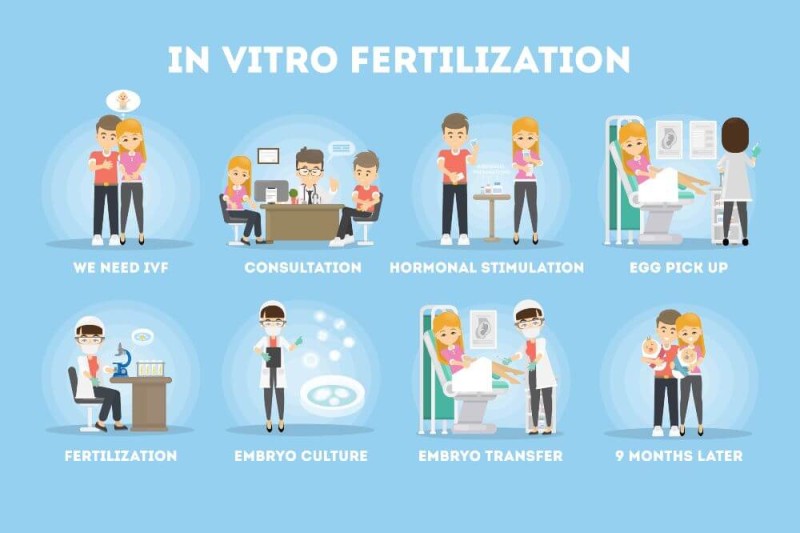IVF is one of the most important medical achievements of the twentieth century. Many infertility cases which were believed to have no hope of having children through IVF suddenly had good prospects and there were many happy success stories. The first to be Louise Brown in 1978.
What is IVF?
The process of IVF consists of collecting oocytes (eggs) from the female partner and sperm from the male partner and in vitro (outside the body) put them in test tubes to give the sperms a chance to fertilize the oocytes naturally. The fertilized eggs now called embryos are put in incubators and returned to the female’s uterus 3-5 days after collecting the eggs.
IVF benefits
The IVF processes has the benefit of excluding the need for the fallopian tubes. This makes it an ideal solution for women with fallopian tube problems like stenosis or blockage. IVF also makes the way sperm cells must travel to reach the egg much shorter and thus is a solution for motility problems.
IVF process step by step
Steps of the IVF process in detail

Step 1: Stimulating the ovaries
In the stimulation phase of IVF, injectable drugs will be used for about 8 to 14 days. These medications hopefully stimulate the ovaries to produce more than one (oocyte) egg and have them grow. You cannot see the actual oocytes on ultrasound sonography, but you can see the follicles in which they grow. This process is closely monitored by regular ultrasound and blood tests for hormone levels (mainly estrogen)
Step 2: Egg Extraction
When according to ultrasound and the levels of estrogen in blood, the patient is ready for the ovum (egg) pick up a Human Gonadotropin (HMG) injection is given to have the female timely ovulate so extraction of the oocytes with the follicular fluid can take place. Blood tests and a consultation with an anesthesiologist will be required before entering the OR.
Step 3: Fertilization
After the eggs are extracted and a semen sample obtained from the male partner, the embryologist processes the semen and puts it together with the oocytes in a test tube for fertilization.
Step 4: Fetal Development
Fetal development begins after fertilization. Embryos will be placed in an incubator and monitored for growth, development and cleavage. The best embryos will be chosen between day 3-5 and transferred into the female’s uterus under ultrasound guidance.
Step 5: Embryo transfer
The Embryo Transfer (ET) is a simple procedure that takes about five minutes. It does not need anesthesia nor a long-time recovery time. After the ET you are required to rest at the hospital for an hour and then you can resume your daily activities.
Step 6: Pregnancy Test
After 14 days from the date of the Embryo Transfer you take a pregnancy test this can either be done in blood serum or urine. WE at Bedaya Hospital always advice you to call us with the test result positive or negative so we can tell you how to proceed.
The IVF process should not be painful but can be slightly uncomfortable due to side effects from the medication (a feeling of being bloated, mood swings, slight dull pain in lower abdomen and back, sensitive breasts). The ovum pickup is done under general anesthesia which can leave you drowsy for 20-30 min after the IVF procedure. If for any health reasons the anesthesiologist thinks you require a local anesthetic you might have to stay with us for 2-3 hours until its totally worn out.
Symptoms after IVF
Apart from the long stressful wait of 2 weeks after an IVF procedure to find out if your trial was successful or not the following may occur in these two weeks.
Light bleeding or spotting
This bleeding does not necessarily mean your IVF trial has failed. It could be an implantation bleeding; it could be due to a microscopic tear in small veins of the cervix due to slight congestion caused by the high levels of progesterone and estrogen in the medication or it could be due to a minor vaginal bleeding after too roughly putting in the prescribed suppositories.
Lower abdominal and back pain
This pain often makes patients nervous because it feels like period pain or cramps. This is a side effect of the endometrium building medication prescribed as one of the IVF steps after the ovum pickup.
Heavy Breasts
Heavy breasts can be the result of the medication prescribed as a normal post IVF step or due to the occurrence of pregnancy. You cannot tell the reason until you do the test 14 days after the ET.
Nausea and fatigue
Nausea or fatigue is often a side effect of elevated progesterone levels this is a side effect of both pregnancy and the medication given after ovum pickup.
Many of the medication side effects simulate those of early pregnancy. This adds to the confusion and anxiety women experience in the 2 weeks wait before they can take the pregnancy test. We at Bedaya Hospital as hard may seem, advice you to engage in activities to take your mind of things and relax during these two weeks.
Advice for woman before IVF
- Exercising
- Drink plenty of water.
- Maintain a healthy variated diet
- Get enough rest
- Discuss your medication program thoroughly with your doctor or medical coordinator to fully understand what is taken when and how. Also notify them of any other medication you might be taking.
- Read up on the process of IVF to avoid unpleasant surprises.
Best foods to eat during IVF treatment
- Eat vegetables and fruits rich in nutrients and antioxidants.
- Choose low-fat proteins, such as fish and poultry.
- Switch to low-fat dairy products.
- Eat plenty of fiber, switch to whole wheat bread, brown rice or pasta.
- Choose a healthy fat source such as; avocados, olive oil, nuts and seeds.
- Avoid red meat, sugar and processed foods.
- Decrease your salt intake and season food with herbs.
Success factors of IVF
To increase the success of IVF steps,
consider these points:
- A hysteroscopy identifies and can help treat uterine problems that could hinder fetal implantation such as uterine septum, polyps, and fibroids.
- A small endometrium scratch improves implantation rates.
Causes of IVF failure
The IVF steps can fail due to:
Poor ovulation
This means that the ovaries do not respond to the stimulating medication with enough oocytes (egg) production and growth. This can be due to poor ovarian reserve or poor ovarian response to the medication.
Lack of quality of eggs or sperm
Bad quality oocytes or sperm account for 75% of IVF failure.
Failure of implantation
Science is still searching for answers as to why under the best of circumstances implantation of embryos in the uterine endometrium sometimes fail to occur. One of the theories is antibodies that attack the embryo or insufficient blood circulation for which in Bedaya Hospital prophylactic measures are taken.
-Bedaya Hospital tailors the steps of IVF for each patient to increase the chances of a healthy pregnancy and a safe delivery.









